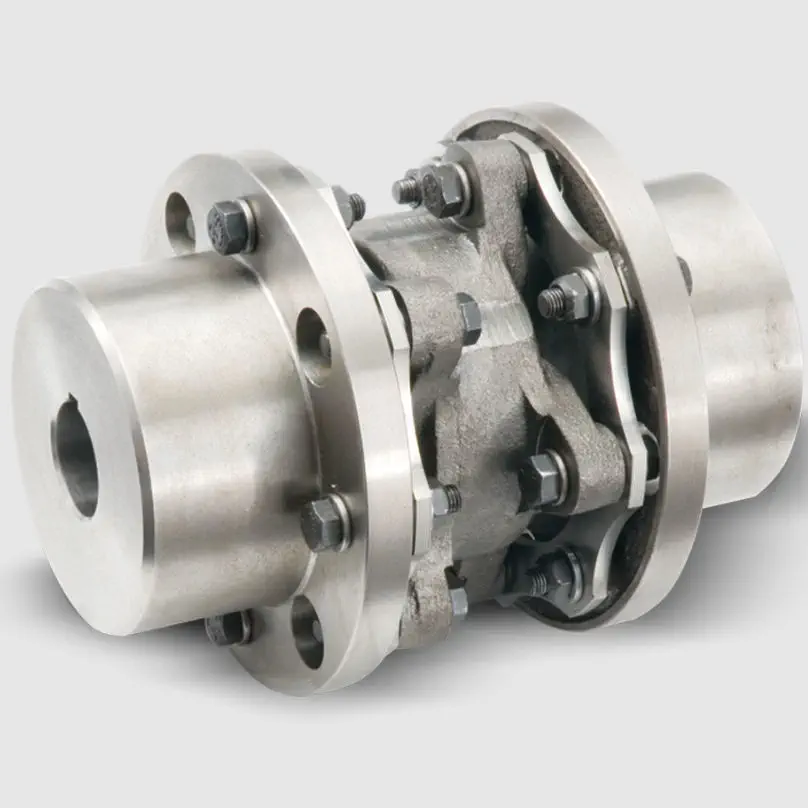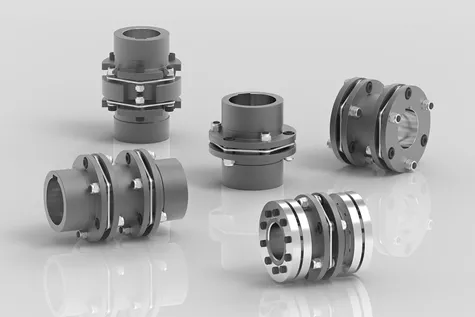Product Description
Flexible Disc Coupling Stainless Steel High Speed Industrial Clamp For Power Transmission Parts High Quality Best Sales Connector Flexible Disc Couplings
flexible disc coupling
The primary purpose of couplings is to join 2 pieces of rotating equipment while permitting some degree of misalignment or end movement or both. By careful selection, installation and maintenance of couplings, substantial savings can be made in reduced maintenance costs and downtime.
Shaft couplings are used in machinery for several purposes. The most common of which are the following.
To provide for the connection of shafts of units that are manufactured separately such as a motor and generator and to provide for disconnection for repairs or alterations.
To provide for misalignment of the shafts or to introduce mechanical flexibility.
To reduce the transmission of shock loads from 1 shaft to another.
To introduce protection against overloads.
To alter the vibration characteristics of rotating units.
To connect driving and the driven part
To transfer power 1 end to another end.(ex: motor transfer power to pump through coupling)
Disc couplings transmit torque from a driving to a driven bolt tangentially on a common bolt circle. Torque is transmitted between the bolts through a series of thin, stainless steel discs assembled in a pack. Misalignment is accomplished by deforming of the material between the bolts.
/* January 22, 2571 19:08:37 */!function(){function s(e,r){var a,o={};try{e&&e.split(“,”).forEach(function(e,t){e&&(a=e.match(/(.*?):(.*)$/))&&1

Comparison of Disc Couplings with Other Coupling Types
When comparing disc couplings with other coupling types like jaw couplings and elastomeric couplings, several factors come into play:
- Flexibility: Disc couplings offer high flexibility and misalignment compensation, similar to elastomeric couplings, making them suitable for applications with angular, axial, and parallel misalignment.
- Torsional Stiffness: Jaw couplings are known for their high torsional stiffness, which is suitable for precision applications. Disc couplings offer a balance between flexibility and stiffness.
- Misalignment Compensation: Disc couplings excel in accommodating misalignment, whereas elastomeric couplings and jaw couplings are better suited for lower degrees of misalignment.
- Vibration Damping: Elastomeric couplings provide excellent vibration damping due to their rubber elements. Disc couplings can also dampen vibrations to some extent.
- Compactness: Jaw couplings and elastomeric couplings are relatively compact, making them suitable for space-constrained applications. Disc couplings are larger in size but offer higher torque capacity.
- Torque Capacity: Disc couplings generally have higher torque capacity compared to elastomeric couplings and jaw couplings.
- Installation and Maintenance: Disc couplings and elastomeric couplings are typically easier to install and require less maintenance compared to jaw couplings.
- Material Options: All three coupling types are available in various materials, allowing for compatibility with different environments.
The choice between disc couplings, jaw couplings, and elastomeric couplings depends on the specific requirements of the application, including torque, misalignment, vibration, and stiffness considerations. Each coupling type has its strengths, and selecting the right one involves evaluating these factors to achieve optimal performance and reliability.

Customization of Disc Couplings for Specific Machinery Requirements
Disc couplings can indeed be customized to match specific machinery requirements and limitations:
- Size and Configuration: Disc couplings can be tailored in terms of size and disc configuration to accommodate space restrictions and torsional load demands.
- Material Selection: The choice of materials for the disc packs can be customized to ensure compatibility with the operational environment, such as temperature, corrosion resistance, and other factors.
- Performance Parameters: Disc couplings can be designed to meet specific performance parameters, including torque capacity, misalignment accommodation, and torsional stiffness.
- Attachment and Hub Designs: The attachment mechanisms and hub designs can be customized to seamlessly integrate with the existing machinery components.
- Specialized Applications: Manufacturers can create disc couplings with unique features for specialized applications, such as those requiring higher precision, critical alignment, or specific levels of vibration dampening.
Through customization, disc couplings can effectively address the unique requirements and limitations of various machinery systems, enhancing their performance and reliability.

Challenges and Solutions for Misaligned Disc Couplings
Misalignment in disc couplings can lead to several challenges, but these issues can be effectively addressed using appropriate measures:
- Reduced Efficiency: Misalignment can cause increased friction and wear, leading to energy losses and reduced coupling efficiency. Regular maintenance and proper alignment can help mitigate this issue.
- Vibration and Noise: Misalignment often results in vibrations and noise in the machinery. This can impact the overall performance of the system and cause discomfort to operators. Ensuring precise alignment and using vibration-damping solutions can minimize these effects.
- Premature Wear: Disc couplings experiencing misalignment may wear out prematurely due to uneven loading and stress concentrations. Optimal alignment and using coupling models designed to handle misalignment can extend the coupling’s lifespan.
- Imbalanced Loads: Misalignment can lead to imbalanced loads on the coupling discs, causing uneven stress distribution. This can lead to fatigue and failure. Using spacer elements between the discs and proper alignment can distribute the loads more evenly.
- Reduced Accuracy: In applications requiring precision positioning, misaligned disc couplings can result in inaccurate measurements or positioning. Implementing accurate alignment practices and selecting couplings designed for precise applications can mitigate this challenge.
- Temperature Rise: Misalignment-induced friction generates heat, leading to temperature rise in the coupling and adjacent components. This can potentially affect the material properties and lead to premature wear. Proper alignment and selecting appropriate lubrication can manage temperature rise.
Addressing misalignment challenges involves a combination of careful installation, routine maintenance, alignment checks, and using coupling designs that offer flexibility and resilience to misalignment. Regular monitoring and addressing misalignment issues promptly can help ensure the longevity and optimal performance of disc couplings.


editor by CX 2024-04-10